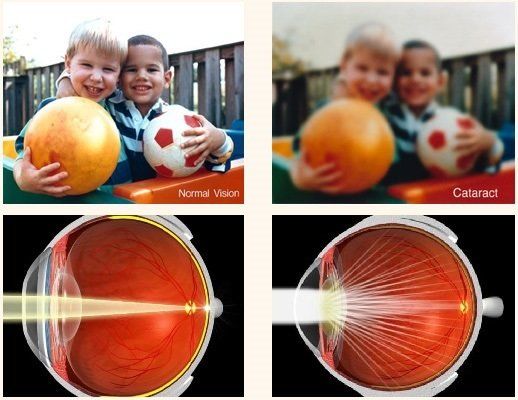Cataract Disease Department


شركة Alcon اللامريكية من اهم شركات اجهزة طب العيون وادقها ويعتبر جهاز ال INFINITY من الاجهزة المستخدمة في عمليات الماء الابيض وبدون تداخل جراحي .
Cataract disease
Alcon, the American company, is one of the most important and most accurate ophthalmology device companies. The INFINITY device is one of the devices used in cataract operations without surgical intervention.
Alcon, the American company, is one of the most important and most accurate ophthalmology device companies. The INFINITY device is one of the devices used in cataract operations without surgical intervention.
Cataract disease
What is cataract disease - white water? What are the causes?
Cataract disease is a disease that affects the natural lens of the eye located behind the pupil of the eye and leads to this lens losing its transparency, which prevents it from performing its function in terms of passing light and focusing it on the retina which makes the affected patient suffer from weak eyesight and blurred vision as if he sees through fog.
The main cause of cataracts is age. So there is a common saying that no human being will not contract this disease if God extends his life and lives until the white water is formed.
It is like greying of the head that usually affects the elderly, but it can occur at an early age (in the thirties or forties of age).
Cataracts can occur at an early age, especially if the patient was exposed to the sun in his youth continuously and without protection by appropriate sunglasses. In rare cases, cataracts can occur as a result of some eye injuries or as a result of an organic disease in the body or as a result of the use of some medications that contain cortisone without the supervision of a doctor.
Symptoms of cataracts
Cataract disease is a disease that affects the natural lens of the eye located behind the pupil of the eye and leads to this lens losing its transparency, which prevents it from performing its function in terms of passing light and focusing it on the retina which makes the affected patient suffer from weak eyesight and blurred vision as if he sees through fog.
The main cause of cataracts is age. So there is a common saying that no human being will not contract this disease if God extends his life and lives until the white water is formed.
It is like greying of the head that usually affects the elderly, but it can occur at an early age (in the thirties or forties of age).
Cataracts can occur at an early age, especially if the patient was exposed to the sun in his youth continuously and without protection by appropriate sunglasses. In rare cases, cataracts can occur as a result of some eye injuries or as a result of an organic disease in the body or as a result of the use of some medications that contain cortisone without the supervision of a doctor.
Symptoms of cataracts
Symptoms vary from case to case and according to the stage in which the severity of the disease is formed. In the early stages, the patient begins to feel a gradual loss of vision with blurring of vision, which leads to the frequent need to change glasses. As the disease progresses, the patient feels a clouding of the eye.
Some also feel glare and intolerance to bright light.
This may result in double lights or reflections, making it difficult to drive the car at night.
If the patient neglects these symptoms, the severity of the disease may increase, which leads to a severe decrease in the sharpness of vision with a change in the colour of the pupil and its colour from normal black to grey or white.
Does it cause sudden vision loss?
Some also feel glare and intolerance to bright light.
This may result in double lights or reflections, making it difficult to drive the car at night.
If the patient neglects these symptoms, the severity of the disease may increase, which leads to a severe decrease in the sharpness of vision with a change in the colour of the pupil and its colour from normal black to grey or white.
Does it cause sudden vision loss?
The loss of vision occurs gradually and over several months, but it is possible that a person does not realize that one of his eyes has opacity of the lens, except suddenly when he covers the healthy eye and discovers by chance that the opacity of the lens prevents vision greatly, which makes him think that he has suddenly lost sight.
How is it possible to treat cataracts now? how does this treatment differ from the old methods?
How is it possible to treat cataracts now? how does this treatment differ from the old methods?
In the old way, that is, the traditional surgery, the eye had to be opened more than 10 mm in order to remove the cataract lens in one block, then the eye was cleaned and closed with several surgical sutures, this led to a long recovery period after the surgery until the wound healed and the stitches were removed (or dissolved), and this took several months after the surgery.
Now, it has become possible to remove the cataract using the modern Phaco technique, which enables access to the lens of the affected eye through an opening whose diameter is no more than about two millimetres (2 mm). Thus, there is no need to use surgical stitches in most cases.
The surgery duration is usually a few minutes, during which all the cataracts are removed easily, making the recovery period short and healing fast.
What are the steps that the patient goes through to perform the phaco surgery?
Now, it has become possible to remove the cataract using the modern Phaco technique, which enables access to the lens of the affected eye through an opening whose diameter is no more than about two millimetres (2 mm). Thus, there is no need to use surgical stitches in most cases.
The surgery duration is usually a few minutes, during which all the cataracts are removed easily, making the recovery period short and healing fast.
What are the steps that the patient goes through to perform the phaco surgery?
After making sure that the cataract is the main cause of poor vision, the patient undergoes tests to determine the size and type of lens to be implanted after removing the cataract. Then the pupils (pupil) of the eye are dilated using drops to examine the retina.
The surgery is performed under local anaesthesia using drops only, where a cover is placed on the eye after the surgery and removed within hours. Then the patient can return to his normal life.
How does the eye look like after the surgery?
The surgery is performed under local anaesthesia using drops only, where a cover is placed on the eye after the surgery and removed within hours. Then the patient can return to his normal life.
How does the eye look like after the surgery?
The eye shape is very natural. It does not show any signs of the surgical operation. There is no eye redness or swelling of the eyelids, because the operation is carried out under local anaesthesia and using only drops.
Is it possible to get rid of vision defects (hyperopia, myopia, and astigmatism) by surgery?
Is it possible to get rid of vision defects (hyperopia, myopia, and astigmatism) by surgery?
Phaco surgery has become one of the most common vision correction surgeries. It is possible to permanently get rid of wearing eyeglasses after removing the cataract by using specialized lenses.
It is also possible to get rid of the use of reading glasses completely.
It is the right of the patient who undergoes this operation to discuss with his/her doctor all types of lenses that are implanted after removing the cataract in order to reach the best option that suits his/her eyes and suits the way and requirements of his/her daily life.
When does the patient return home after the operation? And what are the things to be avoided?
It is also possible to get rid of the use of reading glasses completely.
It is the right of the patient who undergoes this operation to discuss with his/her doctor all types of lenses that are implanted after removing the cataract in order to reach the best option that suits his/her eyes and suits the way and requirements of his/her daily life.
When does the patient return home after the operation? And what are the things to be avoided?
The surgery takes a few minutes and the patient returns home on the same day. In the first days, it is forbidden to put pressure on the eyes with his/her hands. Bathing, washing the face, reading and watching TV are allowed. It is also possible to return to work on the second day after the surgery.
When is it recommended to perform a phaco operation to remove cataracts?
This question is important. Contrary to what is common, it is not necessary to wait for the lens to completely darken or for the person to lose sight completely until the operation can be performed. It was previously believed that cataracts must mature before surgery. But with the advancement of treatment methods and the invention of modern technologies, the date of the operation can be determined when the opacity of the lens causes a weakness in vision to the extent that the person is unable to carry out his usual activity and practice his/her daily life normally.
When can the patient see after the phaco operation?
As the lens of the eye affected by cataract disease is replaced after the operation with a transparent lens that is easily implanted inside the eye, the patient can see from the first day and the vision becomes clearer with the passage of time and vision returns to its normal condition before the cataract occurred. Unless there are previous diseases in the retina.
What are the tips that help prevent and early diagnosis of cataracts?
Since the opacity of the lens increases as a result of age, people over the age of forty and belonging to families in which cataracts have occurred, should take the initiative to examine their eyes periodically until an early diagnosis is made. Also, people with organic diseases such as diabetes, or who use cortisone for a long time, should review the eye consultant periodically because they have a greater chance of suffering from cataracts at a younger age than usual. Also, pregnant women should not mix with people who carry infectious diseases so that the fetus does not get congenital cataract.
To avoid cataract disease resulting from injuries or blows to the eye, protective glasses must be put on when using sharp instruments or radioactive materials or when performing various carpentry or blacksmithing work.
When is it recommended to perform a phaco operation to remove cataracts?
This question is important. Contrary to what is common, it is not necessary to wait for the lens to completely darken or for the person to lose sight completely until the operation can be performed. It was previously believed that cataracts must mature before surgery. But with the advancement of treatment methods and the invention of modern technologies, the date of the operation can be determined when the opacity of the lens causes a weakness in vision to the extent that the person is unable to carry out his usual activity and practice his/her daily life normally.
When can the patient see after the phaco operation?
As the lens of the eye affected by cataract disease is replaced after the operation with a transparent lens that is easily implanted inside the eye, the patient can see from the first day and the vision becomes clearer with the passage of time and vision returns to its normal condition before the cataract occurred. Unless there are previous diseases in the retina.
What are the tips that help prevent and early diagnosis of cataracts?
Since the opacity of the lens increases as a result of age, people over the age of forty and belonging to families in which cataracts have occurred, should take the initiative to examine their eyes periodically until an early diagnosis is made. Also, people with organic diseases such as diabetes, or who use cortisone for a long time, should review the eye consultant periodically because they have a greater chance of suffering from cataracts at a younger age than usual. Also, pregnant women should not mix with people who carry infectious diseases so that the fetus does not get congenital cataract.
To avoid cataract disease resulting from injuries or blows to the eye, protective glasses must be put on when using sharp instruments or radioactive materials or when performing various carpentry or blacksmithing work.
Finally, it must be clarified that there is no way to permanently prevent opacity with age, but it is possible to prevent vision loss through proper diagnosis and early treatment.







